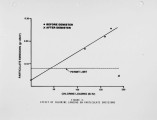| Title |
Operating Experiences With EPA's Mobile Incineration System |
| Creator |
Gupta, Gopal D.; Sawyer, R. ; Freestone, F. ; Hazel, R. |
| Publisher |
University of Utah |
| Date |
1987 |
| Spatial Coverage |
presented at Palm Springs, California |
| Abstract |
This paper describes the recent modifications made to the U.S. Environmental Protection Agency's (EPA) mobile incineration system. These modifications were made to increase the capacity of the system and to improve its on-stream factor. The operation of the modified system began on June 1, 1987. During the following three month period various system performance tests were conducted. Additionally, over a million pounds of dioxin-contaminated solids and liquids including soil, plastics, trash, grass, Tyvek clothing, wood etc. have been incinerated. A brief summary of the various test results, the highlights of the major problems encountered during the system operation, adopted solutions, and lessons learned are presented. The information presented will be of interest to those considering operation of mobile or transportable incineration systems under field conditions for the purpose of cleanup of Superfund or other hazardous waste sites. |
| Type |
Text |
| Format |
application/pdf |
| Language |
eng |
| Rights |
This material may be protected by copyright. Permission required for use in any form. For further information please contact the American Flame Research Committee. |
| Conversion Specifications |
Original scanned with Canon EOS-1Ds Mark II, 16.7 megapixel digital camera and saved as 400 ppi uncompressed TIFF, 16 bit depth. |
| Scanning Technician |
Cliodhna Davis |
| ARK |
ark:/87278/s6v40xrp |
| Setname |
uu_afrc |
| ID |
4445 |
| Reference URL |
https://collections.lib.utah.edu/ark:/87278/s6v40xrp |


























